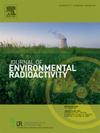Interception and uptake by plants leaves of tritium from precipitation
IF 1.9
3区 环境科学与生态学
Q3 ENVIRONMENTAL SCIENCES
引用次数: 0
Abstract
The Radiological and environmental impact assessment models are used for evaluating the radiological impact of actual and potential releases of radionuclides into the environment. For tritium, a special radionuclide that readily enters into many organic forms, the processes involved in its interception and uptake by plant leaves during a tritiated rain are complex and not yet well understood. When rain containing tritiated water (HTO) starts, water is retained progressively on leaves up to a maximum storage capacity and also evaporates from the wet canopy part. The dynamics of leaf HTO concentration depends also on rain intensity and duration. In the absence of experimental data for leaf HTO concentration due to tritiated rain, various processes of potential importance are presented. Processes such as: leaf interception during rain event, interaction between drops and leaf surface, and extension of water layer (adhesion fraction) are described in the present study. Recent results on pesticide spray and sprinkler irrigation experiments and modelling approaches are used, because they provide useful information for the interaction between water droplets and the leaf surface. The rain drop diameter distribution and the associated drop falling velocity are linked with the washout studies and past results for tritium are used. The main crops (i.e. wheat, maize, barley, soybean, oilseed rape, and grape) around Cernavoda Nuclear Power Plant (Romania), operating two CANDU 6 units with high tritium loads are considered. For radiological impact assessment of tritium, the tritiated rain on crops at harvest for normal and/or short term and intense tritium release are presented.
植物叶片从降水中截取和吸收氚
放射性和环境影响评价模型用于评价放射性核素实际和潜在向环境释放的放射性影响。氚是一种特殊的放射性核素,很容易进入许多有机形式,在氚化降雨期间,植物叶片对其拦截和吸收的过程很复杂,目前还没有得到很好的理解。当含有氚化水(HTO)的雨水开始时,水分逐渐保留在树叶上,达到最大储存容量,同时也从潮湿的冠层部分蒸发。叶片HTO浓度的动态还取决于降雨强度和持续时间。在缺乏由氚化雨引起的叶片HTO浓度的实验数据的情况下,提出了各种可能重要的过程。本文描述了降雨过程中叶片的截留、雨滴与叶片表面的相互作用以及水层的扩展(附着分数)等过程。本文采用了农药喷洒和喷灌试验的最新结果和建模方法,因为它们为水滴与叶片表面之间的相互作用提供了有用的信息。雨滴直径分布和相关的雨滴下降速度与冲刷研究相联系,并使用了过去对氚的结果。考虑了运行两个高氚负荷CANDU 6机组的切尔纳沃达核电站(罗马尼亚)周围的主要作物(即小麦、玉米、大麦、大豆、油菜和葡萄)。对于氚的放射性影响评价,提出了在收获时对作物进行氚化雨的正常和/或短期和强烈的氚释放。
本文章由计算机程序翻译,如有差异,请以英文原文为准。
求助全文
约1分钟内获得全文
求助全文
来源期刊

Journal of environmental radioactivity
环境科学-环境科学
CiteScore
4.70
自引率
13.00%
发文量
209
审稿时长
73 days
期刊介绍:
The Journal of Environmental Radioactivity provides a coherent international forum for publication of original research or review papers on any aspect of the occurrence of radioactivity in natural systems.
Relevant subject areas range from applications of environmental radionuclides as mechanistic or timescale tracers of natural processes to assessments of the radioecological or radiological effects of ambient radioactivity. Papers deal with naturally occurring nuclides or with those created and released by man through nuclear weapons manufacture and testing, energy production, fuel-cycle technology, etc. Reports on radioactivity in the oceans, sediments, rivers, lakes, groundwaters, soils, atmosphere and all divisions of the biosphere are welcomed, but these should not simply be of a monitoring nature unless the data are particularly innovative.
 求助内容:
求助内容: 应助结果提醒方式:
应助结果提醒方式:


